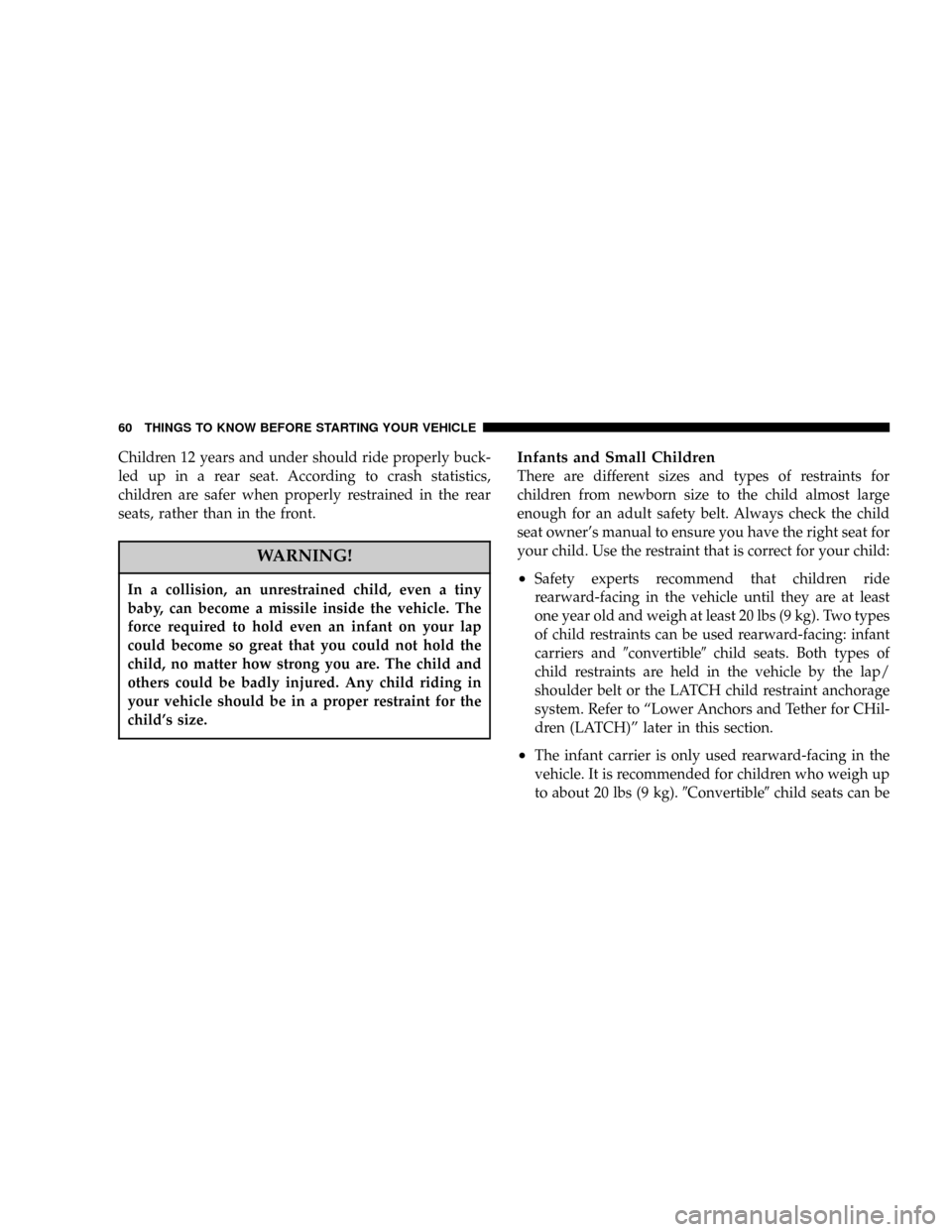2004 CHRYSLER TOWN AND COUNTRY child restraint
[x] Cancel search: child restraintPage 10 of 401

mVehicle Theft Alarm Ð If Equipped...........27
mSliding Side Door........................28
NPower Sliding Door Ð If Equipped.........30
NChild Protection Door Lock...............32
mLiftgate...............................34
NPower Liftgate Ð If Equipped.............35
mWindows.............................38
NPower Vent Windows...................38
NPower Windows.......................38
mOccupant Restraints......................39
NLap/Shoulder Belts.....................40
NLap/Shoulder Belt Untwisting Procedure.....46
NCenter Lap Belts.......................48NSeat Belt Pretensioners...................48
NSeat Belts And Pregnant Women............49
NSeat Belt Extender......................49
NDriver And Front Passenger Supplemental
Restraint System - Airbag................50
NSide Airbags Supplemental Restraint System
(SRS) Ð If Equipped....................56
NDaimlerChrysler Corporation Integrated
Child Seat Ð If Equipped................59
NChild Restraint........................59
mRear Seat Delete Feature (Commercial Vehicles
Only) Ð If Equipped.....................68
NRestraining Infants And Small Children With Seat
Delete Feature (Commercial Vehicles Only)....69
mEngine Break-In Recommendations...........72
10 THINGS TO KNOW BEFORE STARTING YOUR VEHICLE
Page 39 of 401

Auto Down Feature Ð If Equipped
The driver's window switch has an auto down feature.
Press the window switch past the detent, release, and the
window will go down automatically.
To open the window part way, press the window switch
part way and release it when you want the window to
stop.
The power window switches remain active for up to 45
seconds after the ignition switch has been turned off.
Opening a vehicle front door will cancel this feature.
Wind Buffeting
Wind buffeting can be described as the perception of
pressure on the ears or a helicopter type sound in the
ears. Your vehicle may exhibit wind buffeting with the
windows down, or the sunroof (if equipped) in certain
open or partially open positions. This is a normal occur-
rence and can be minimized. If the buffeting occurs with
the rear windows open, open the front and rear windowstogether to minimize the buffeting. If the buffeting occurs
with the sunroof open, adjust the sunroof opening to
minimize the buffeting.
OCCUPANT RESTRAINTS
Some of the most important safety features in your
vehicle are the restraint systems. These include the front
and rear seat belts for the driver and all passengers, front
airbags for both the driver and front passenger and if
equipped, side airbags for both the driver and front
passenger. If you will be carrying children too small for
adult-size seat belts, your seat belts or the LATCH feature
(Lower Anchors and Tether for CHildren) also, can be
used to hold infant and child restraint systems.
Please pay close attention to the information in this
section. It tells you how to use your restraint system
properly to keep you and your passengers as safe as
possible.
THINGS TO KNOW BEFORE STARTING YOUR VEHICLE 39
2
Page 52 of 401

Airbags inflate in moderate to high speed impacts. Along
with seat belts and pretensioners, front airbags work with
the instrument panel knee bolsters to provide improved
protection for the driver and front passenger. Side airbags
also work with seat belts to improve occupant protection.
The seat belts are designed to protect you in many types
of collisions. The front airbags deploy in moderate to
severe frontal collisions. If your vehicle is equipped, the
side airbag on the crash side of the vehicle is triggered in
moderate to severe side collisions. In certain types of
collisions, both the front and side airbags may be trig-
gered. But even in collisions where the airbags deploy,
you need the seat belts to keep you in the right position
for the airbags to protect you properly.
Here are some simple steps you can take to minimize the
risk of harm from a deploying airbag.
1.Children 12 years old and under should always ride
buckled up in a rear seat.Infants in rear facing child restraints shouldNEVERride
in the front seat of a vehicle with a passenger front airbag.
An airbag deployment can cause severe injury or death to
infants in that position.
Children that are not big enough to properly wear the
vehicle seat belt (refer to section on Child Restraint)
should be secured in the rear seat, in a child restraint or
belt-positioning booster seat. Older children who do not
use child restraints or belt-positioning booster seats
should ride properly buckled up in the rear seat, and in
the outboard seat if possible. Never allow children to
slide the shoulder belt behind them or under their arm.
If a child from 1 to 12 years old must ride in the front
passenger seat because the vehicle is crowded, move the
seat as far back as possible, and use the proper child
restraint. See the section on Child Restraint.
You should read the instructions provided with your
child restraint to make sure that you are using it properly.
52 THINGS TO KNOW BEFORE STARTING YOUR VEHICLE
Page 56 of 401

Side Airbags Supplemental Restraint System
(SRS) Ð If Equipped
The Side Airbag System, if equipped, consists of the
following:
²AIRBAG Readiness Light (shared with the front airbag
system)
²Side Airbag in the driver's seat
²Side Airbag in the passenger's seat
²Front Airbag Control Module (with integrated side
impact sensor - if equipped)
²Interconnecting Wiring
How The Side Airbag System Works
Thefrontairbag control modules determine if a side
collision is severe enough to require the side airbags to
inflate. The front airbag control modules will not detect
roll over, or rear collisions.The front airbag control module also monitors the readi-
ness of the electronic parts of the system whenever the
ignition switch is in the START or ON positions. These
include all of the items listed above except the knee
bolster, instrument panel and the steering wheel and
column. If the key is in the OFF position, in the ACC
position, or not in the ignition switch, the side airbags are
not on and will not inflate.
In moderate to severe side collisions, the side airbag
inflator on the crash side of the vehicle is triggered,
releasing a quantity of nontoxic gas. The inflating side
airbag exits through the seat seam into the space between
the occupant and the door. The side airbag moves at a
very high speed and with such a high force that it could
injure you if you are not seated properly, or if items are
positioned in the area where the side airbag inflates. This
especially applies to children.
56 THINGS TO KNOW BEFORE STARTING YOUR VEHICLE
Page 59 of 401

Airbag Light
You will want to have the airbags ready to inflate for your
protection in a collision. While the airbag system is
designed to be maintenance free, if any of the following
occurs, have an authorized dealer service the system
immediately.
²The AIRBAG light does not come on or flickers during
the 6 to 8 seconds when the ignition switch is first
turned on.
²The light remains on or flickers after the 6 to 8 second
interval.
²The light flickers or comes on and remains on while
driving.
DaimlerChrysler Corporation Integrated Child
Seat Ð If Equipped
Operating instructions for this seat are included with the
seat. If the instructions are not with the seat or in the
Owner's Manual Package, replacement instructions can
be obtained.
To obtain Integrated Child Seat replacement
instructions:
Use the order form at the back of this manual and specify
publication number 81-016-1950.
Child Restraint
Everyone in your vehicle needs to be buckled up at all
times Ð babies and children, too. Every state in the
United States and all Canadian provinces require that
small children ride in proper restraint systems. This is the
law, and you can be prosecuted for ignoring it.
THINGS TO KNOW BEFORE STARTING YOUR VEHICLE 59
2
Page 60 of 401

Children 12 years and under should ride properly buck-
led up in a rear seat. According to crash statistics,
children are safer when properly restrained in the rear
seats, rather than in the front.
WARNING!
In a collision, an unrestrained child, even a tiny
baby, can become a missile inside the vehicle. The
force required to hold even an infant on your lap
could become so great that you could not hold the
child, no matter how strong you are. The child and
others could be badly injured. Any child riding in
your vehicle should be in a proper restraint for the
child's size.
Infants and Small Children
There are different sizes and types of restraints for
children from newborn size to the child almost large
enough for an adult safety belt. Always check the child
seat owner's manual to ensure you have the right seat for
your child. Use the restraint that is correct for your child:
²Safety experts recommend that children ride
rearward-facing in the vehicle until they are at least
one year old and weigh at least 20 lbs (9 kg). Two types
of child restraints can be used rearward-facing: infant
carriers and9convertible9child seats. Both types of
child restraints are held in the vehicle by the lap/
shoulder belt or the LATCH child restraint anchorage
system. Refer to ªLower Anchors and Tether for CHil-
dren (LATCH)º later in this section.
²The infant carrier is only used rearward-facing in the
vehicle. It is recommended for children who weigh up
to about 20 lbs (9 kg).9Convertible9child seats can be
60 THINGS TO KNOW BEFORE STARTING YOUR VEHICLE
Page 61 of 401

used either rearward-facing or forward-facing in the
vehicle. Convertible child seats often have a higher
weight limit in the rearward-facing direction than
infant carriers do, so they can be used rearward-facing
by children who weigh more than 20 lbs (9 kg) but are
less than one year old.
²Rearward-facing child seats mustNEVERbe used in
the front seat of a vehicle with a front passenger
airbag. An airbag deployment could cause severe
injury or death to infants in this position.
²Children who weigh more than 20 lbs (9 kg) and who
are older than one year can ride forward-facing in the
vehicle. Forward-facing child seats and convertible
child seats used in the forward-facing direction are for
children who weigh 20 to 40 lbs (9 to 18 kg) and who
are older than one year. These child seats are also held
in the vehicle by the lap/shoulder belt or the LATCHchild restraint anchorage system. Refer to ªLower
Anchors and Tether for CHildren (LATCH)º later in
this section.
²The belt-positioning booster seat is for children weigh-
ing more than 40 lbs (18 kg), but who are still too small
to fit the vehicle's seat belts properly. If the child can
not sit with knees bent over the vehicles seat cushion
while the child's back is against the seat back, they
should use a belt-positioning booster seat. The child
and booster seat are held in the vehicle by the lap/
shoulder belt. (Some booster seats are equipped with a
front shield and are held in the vehicle by the lap
portion.)
NOTE:For additional information refer to
www.seatcheck.org.
THINGS TO KNOW BEFORE STARTING YOUR VEHICLE 61
2
Page 62 of 401

WARNING!
²Improper installation can lead to failure of an
infant or child restraint. It could come loose in a
collision. The child could be badly injured or
killed. Follow the manufacturer's directions ex-
actly when installing an infant or child restraint.
²A rearward facing child restraint should only be
used in a rear seat. A rearward facing child re-
straint in the front seat may be struck by a
deploying passenger airbag which may cause se-
vere or fatal injury to the infant.
Here are some tips on getting the most out of your child
restraint:
²Before buying any restraint system, make sure that it
has a label certifying that it meets all applicable Safety
Standards. We also recommend that you make surethat you can install the child restraint in the vehicle
where you will use it, before you buy it.
²The restraint must be appropriate for your child's
weight and height. Check the label on the restraint for
weight and height limits.
²Carefully follow the instructions that come with the
restraint. If you install the restraint improperly, it may
not work when you need it.
The passenger seat belts are equipped with cinching
latch plates, which are designed to keep the lap
portion tight around the child restraint so that it is not
necessary to use a locking clip. Pulling up on the
shoulder portion of the lap/shoulder belt will tighten
the belt. The cinching latch plate will keep the belt
tight, however, any seat belt system will loosen with
time, so check the belt occasionally and pull it tight if
necessary.
62 THINGS TO KNOW BEFORE STARTING YOUR VEHICLE